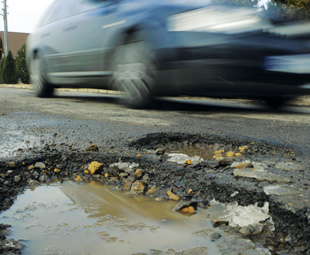Rainy days and washaways

The JRA faces an uphill battle as the rainy season has again washed away the best of Joburg’s roads
Humans are strange … aren’t we? Each winter we whine about how cold it is, despite knowing that low mercury levels define the season. Then, as the seasons change, we welcome back the warm embrace of summer and groan about the desperate need for rain. Eventually the rain returns – at which point we moan about it…
At least, that’s how it is for those of us living on the highveld. In fairness, though, the clouds creating those fabled highveld thunderstorms do seem to be darker, the flooding seems to be deeper, while the hailstones seem to have increased in size from golf ball to cricket ball.
Naturally, Gauteng’s ever-ailing road infrastructure takes a knock during the rainy season (and, naturally, we act surprised). In the last couple of months it’s been a repeat case of watching traffic lights go out, potholes develop, or roads wash away. Not that the authorities haven’t been trying … the Johannesburg Roads Agency (JRA), for example, has been busy in 2017, but its State of Joburg’s Road Network report (issued during November) makes for some disheartening reading.
The study identified and categorised the city’s 13 599 km road network for maintenance, reconstruction, resurfacing and gravel-road upgrades. According to Goodwill Mbatha, acting MD of the JRA, in terms of engineering standards the condition of the city’s road network has deteriorated by 25 percent.
The report states that, compared to the 2013 report, “very good” and “good” surfaced roads have decreased from 52 to 45 percent, while “poor” and “very poor” roads have increased from 27 to 32 percent.
It continues that 32 percent of surfaced roads (3 968 km) require reconstruction, 45 percent of surfaced roads (5 581 km) require ad hoc maintenance, and 23 percent of surfaced roads (2 852 km) require resurfacing. Of the 1 168 km of gravel roads, 72 percent require reshaping and re-gravelling.
The JRA says that surfaced roads have an average lifespan of ten years. Its annual target across the total road network for surfacing is ten percent. and five percent for reconstruction. However, due to budgetary constraints, only one percent is resurfaced and 0,02 percent is reconstructed.
Considering the cost per kilometre for reconstruction is R4 million and R1 million for resurfacing, it is little wonder the Agency’s allocated 2017/18 roads budget of R247 million (split R100 million and R147 million respectively) doesn’t go very far.
And the scariest statement in the report? “Due to historical underinvestment in roads prior to 2013, compounded by deterioration as a result of climatic conditions, increased traffic volume and the percentage of heavy-duty vehicles, Johannesburg’s road network is at present faced with a R7,1 billion backlog – of which road resurfacing requires R4,26 billion and reconstruction R2,84 billion.”
As the agency continues its ten-year Roads Development Plan to achieve targeted road conditions across the city by 2023, it has at least received a R88-million boost (during March) from Mayor Herman Mashaba to address the backlog of pothole repairs.
Between July and October 17, the JRA spent R199 632,23 on addressing 4 750 of the 5 603 pothole repair requests it received (the remainder are scheduled).
The agency also says that its maintenance teams across the city’s seven regions have shown great improvement in addressing pothole backlogs, with a total of 29 496 pothole repairs carried out within 30 days at a resolution rate of 84,72 percent.
At least that’s something Joburg’s residents can really get excited about!
Published by
Focus on Transport
focusmagsa



